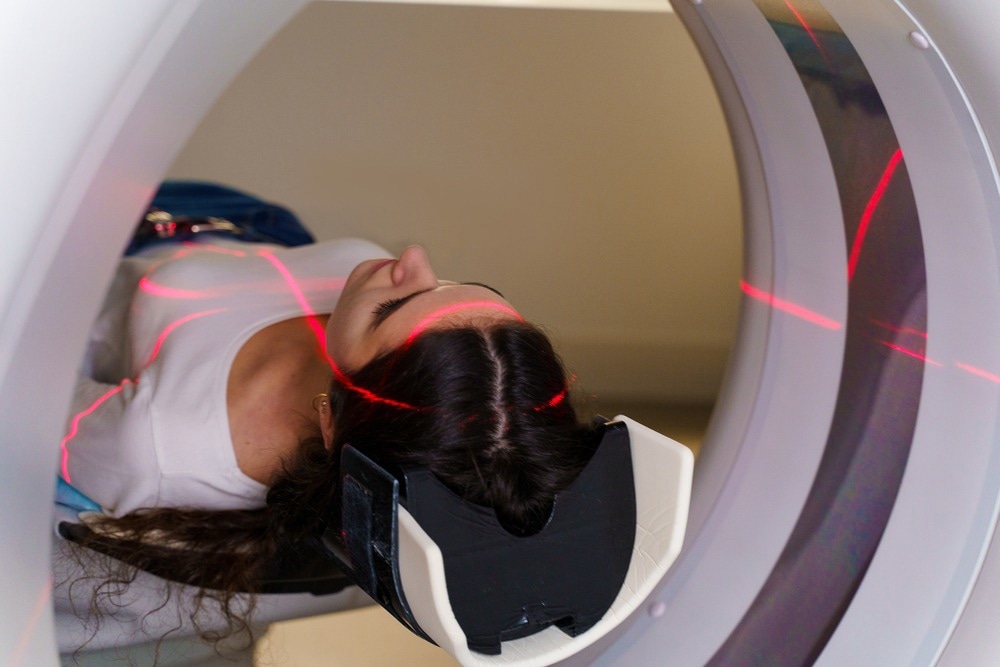Robots are incredibly useful in magnetic resonance imaging (MRI). Usage includes MRI-guided therapies, from aiding precision targeting to assisting the maneuver of high-dexterity surgery tools. However, the full potential of robotics applications in MRI has yet to be realized.

Image Credit: Rabizo Anatolii/Shutterstock.com
It is likely as research continues, the integration of robotics into this field of imaging will help forge the way for novel, MRI-guided therapy options. There is a significant opportunity to improve the standard of care for many diseases by focussing on fully integrating robotics into MRI.
Here, we give an overview of the challenges that must be overcome before the integration of robotics into MRI can reach its full potential.
Why Apply Robotics into MRI?
In the 1990s, Masamune and colleagues at the University of Tokyo developed the first example of robotics in MRI. Following the recent developments of medical robots for stereotactic neurosurgery using computed tomography (CT), the team at the University of Tokyo embarked on a project to ingrate robotics into an MRI environment. They created a system frame out of polyethylene terephthalate (PET) that was actuated using ultrasonic motors. The resultant MRI-compatible motorized stereotactic frame was successfully used for neurosurgery purposes.
In the years that followed, research into MRI-guided robotics continued rapidly. Early on, other stereotactic devices were invented, such as the 0.5T open-configuration scanner used in prostate intervention, and the closed-bore scanner used in breast interventions.
Since then, numerous successes in this field have been achieved. Many systems and prototypes have been developed for various MRI-guided interventions, including for those treating the brain, breast, kidney, and prostate, and general percutaneous procedures.
Current Challenges to Overcome
To allow for more robotic MRI systems to be developed and adopted by the medical field, there are several challenges that must first be addressed. The first of these is the issue of material restriction.
Choices regarding materials used in robotic MRI systems are heavily restricted and is one of the major challenges researchers working in this field currently face. Due to the nature of MRI, which relies on a strong magnetic field, no ferromagnetic metals can be used. In terms of robotic MRI systems for neurosurgery, components usually include a head frame, transmission, and robotic end effector. Materials to create these components must be strong but also lightweight, further limiting the list of potential materials.
There are also challenges to engineering the actuators used in MRI-guided robotic systems. Again, they must not be made from ferromagnetic metals; in addition, they are required to provide sub-millimeter accuracy, imposing restrictions on the kind of materials used in the actuators.
The magnetic field of the MRI machine also impacts the functioning of the motors used within actuators. While ultrasonic and piezoelectric motors are good for providing high levels of accuracy, they must not be placed close to the MR bore, as this will disrupt the proper functioning of the motors. These factors must be considered when designing MRI-guided robotic systems.
While some materials have proven effective in studies, such as shape memory alloy (SMA), their use in clinical applications remains restricted - in the case of SMA, low actuation frequency and hysteretic performance make clinical implementation challenging. Pneumatic motors and hydraulic motors are alternative choices for actuators; however, they carry the risks of fluid leakage and cavitation. Overall, there is a need for new actuators to be developed for the specific purpose of use in MRI-guided robotic systems.
The final key challenge currently hindering the development of MRI-guided robotic systems is the use of sensors. Flexible sensors must also be used in applications that require the use of flexible robots, such as those used for MRI-guided procedures, including abdominal, breast biopsy, and prostate procedures.
Force sensing and shape sensing are key elements of MRI-guided procedures, it allows the flexible robot to be closely monitored and for its movements to be fine-tuned so that it can efficiently interact with its surroundings. These sensors require MRI-compatible trackers; however, the availability of such trackers is fairly limited. Few sensors are available on the market, and many are large and bulky and inappropriate for certain applications.
Overall, there is a need for the evolution of sophisticated hardware for use in MRI-guided robotic systems. Currently, available materials and technology are often inappropriate for the applications of MRI-guided robotic systems. Without specifically designed technology, the integration of robotics into MRI will struggle to reach its full potential. Fortunately, given the high level of interest in the field, it is likely that such advances will occur in the coming years.
References and Further Reading
Erin, O., Boyvat, M., Tiryaki, M., Phelan, M. and Sitti, M., 2020. Magnetic Resonance Imaging System–Driven Medical Robotics. Advanced Intelligent Systems, 2(2), p.1900110. https://onlinelibrary.wiley.com/doi/10.1002/aisy.201900110
Hata, N., Moreira, P. and Fischer, G., 2018. Robotics in MRI-Guided Interventions. Topics in Magnetic Resonance Imaging, 27(1), pp.19-23. https://journals.lww.com/topicsinmri/Fulltext/2018/02000/Robotics_in_MRI_Guided_Interventions.6.aspx
Li, C., King, N. and Ren, H., 2018. A Skull-Mounted Robot with a Compact and Lightweight Parallel Mechanism for Positioning in Minimally Invasive Neurosurgery. Annals of Biomedical Engineering, 46(10), pp.1465-1478. https://pubmed.ncbi.nlm.nih.gov/29687238/
Masamune, K., Kobayashi, E., Masutani, Y., Suzuki, M., Dohi, T., Iseki, H. and Takakura, K., 1995. Development of an MRI-compatible needle insertion manipulator for stereotactic neurosurgery. Journal of Image Guided Surgery, 1(4), pp.242-248. https://pubmed.ncbi.nlm.nih.gov/9079451/
Disclaimer: The views expressed here are those of the author expressed in their private capacity and do not necessarily represent the views of AZoM.com Limited T/A AZoNetwork the owner and operator of this website. This disclaimer forms part of the Terms and conditions of use of this website.